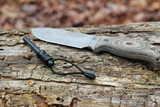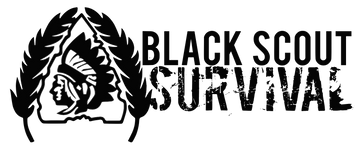How to choose a Survival Knife

Knives are one of the most important pieces of gear you can have in a survival situation. With the proper knowledge and training in fundamental survival skills they can provide shelter, fire, water, and food. Most tools have specific functions; knives are no different. There are certain features that will greatly enhance a knife’s performance in a survival situation.
Generally speaking there are two types of knives: folding and fixed blade.
FOLDING KNIVES
Folding knives are most commonly carried on a daily basis also known as EDC (or every day carry). Typically these knives are designed for general duties like opening boxes, cutting zip ties, or preparing food. These knives offer the advantage of being easily clipped inside a pants pocket. The major disadvantage is that they have a “joint” where the knife folds. If used for rigorous duty (like you would need to in a survival situation) it could fail at that pivot point rendering the knife useless.
FIXED BLADE KNIVES
The term fixed blade means the knife is of solid construction where the blade material extends into the handle and does not fold or have any moving parts. They are commonly referred to as a “sheath knife”. Ideally this is your best option for a wilderness knife.
SURVIVAL KNIFE CRITERIA
There are a few specific features that I look for when selecting a survival knife:
- 4-6” blade length
- Full tang
- Proper blade profile
- Ergonomic handle
- Blade steel
BLADE LENGTH
In my experience a 4-6 inch blade can tackle a multitude of tasks that you may face in a survival situation. It’s large enough to do more serious work such as constructing shelters, but not too large to do fine work like cleaning/dressing small game.
FULL TANG
Not all fixed blade knives are created equal. A full tang design essentially means that the blade material extends into the handle of the knife. In essence one continuous piece of steel with handles bolted on. This construction will give you the most dependable tool for survival applications and will resist breakage.
BLADE PROFILE
The blade should feature a drop or spear point design that will provide the most tip strength. This is important if you must do any prying or digging with the knife.
Another important feature is that the blade only has one sharpened edge. Meaning the spine of the knife is not sharpened. This is crucial when splitting wood with a method called batoning. This technique is used to split wood by using a baton sized stick as a mallet to strike the spine of the knife repeatedly, driving the knife through a log. Some knives have serrations on the blade and are designed to cut through rope quickly. Serrations sacrifice precious blade real estate and are difficult to sharpen.
ERGONOMIC HANDLE
Understand that you may be using the knife for long periods of time and having a comfortable handle is necessary. Poorly designed handles will cause hand fatigue from repetitive motion that can result in injury. I prefer knives with a Micarta handle that will retain proper grip even when wet. Stay away from wooden handles that may crack in extreme temperature changes or swell when exposed to water. Another feature I recommend is a lanyard hole at the butt end of the handle that can be used to tether the knife to your wrist to prevent loss.
BLADE STEEL
Typically there are two blade steel types: carbon and stainless. Each have their own advantages/disadvantages. Carbon steels are generally harder than stainless alloys but are susceptible to corrosion from the elements. Stainless tends to dull quicker but will be more corrosion resistant for inclement or wet weather. Deciding which is best for you will depend on your environment or activity.
MAINTENANCE
Like any tool a knife will require periodic maintenance. A whetstone will put an edge back on a dull knife. I also recommend carrying an oil to prevent rest. Carry a food grade variety like olive oil if your plan prepare any meals with you knife.
You cannot predict the length of time you may be placed in a survival situation. It is important to select a knife that you trust and that is capable of taking on any challenge you may face in the wild.
